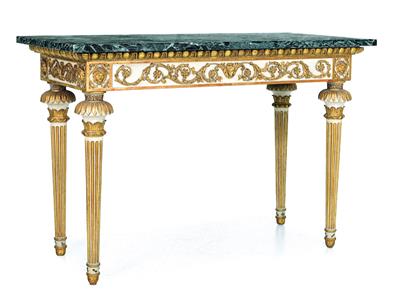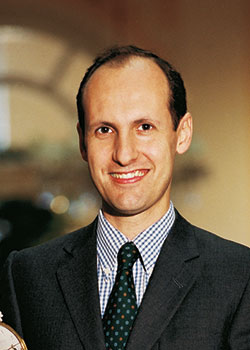A Neo-Classical console table,

late 18th century, cream-colour painted softwood frame on conical fluted legs, gilt, frieze with carved applications in the the form or floral festoons, the corners with moulded Medusa heads in rhomboid frames, terminating with bulls-eye mouldings, marble top of a later date, 87 x 131 x 64 cm, 1 Medusa head missing, the colour partly painted over, nevertheless the applications are untouched, inventory label no. 577 on the underside, signs of age and use.
Provenance:
formerly Palais Modena in Vienna (today Ministry of the Interior)
Empress Maria Theresia of Austria put great effort into securing dynastic relations between the House of Habsburg and Italian princely families. It was planned to connect the Duchy of Modena with the House of Habsburg by way of a marriage.
Archduke Ferdinand Karl married Duchess Maria Beatrice d’Este on 15 October 1771 in Milan.
In 1780, Ferdinand Karl was made Governor of Lombardy.
In 1796, Napoleon’s invasion of Milan forced the family to flee. After spending time in Trieste and Brünn, the Duchess settled in Wiener Neustadt with some of her nine children, while Ferdinand Karl took up residence in Schloss Belvedere in Vienna, along with his eldest sons.
In 1811, Maria Beatrice of Austria-Este purchased the palace on Herrengasse from Prince Franz Joseph von Dietrichstein.
In 1808, her youngest daughter, Maria, married Ludovik Franz I of Austria.
In 1814, Maria Beatrice of Austria-Este arranged for the palace to be renovated in the neoclassical style, in line with plans drawn up by Alois Pichl.
Thanks to the relationship between her mother, Maria Teresa Cybo-Malaspina, and Giacomo Quarenghi, who was the architect used by Catherine the Great, Tsar Paul and Tsar Alexander I, it was possible to bring Quarenghi to Vienna to handle the interior design and furnishings for the palace. The palace was intended to represent the family’s high status, due to her daughter’s marriage to Austrian Emperor Franz I. The furnishings and fittings of the palace came from the furniture reserves of the imperial family. When selecting furnishings, Quarenghi focused on Italian pieces from the 18th century, and various Baroque works.
In 1814, Maria Beatrice of Austria-Este took on the governance of the duchies of Massa and Carra, which she had inherited from her mother. After Maria Beatrice's death in Vienna in 1829, these duchies were combined with Modena.
In 1816, Maria Ludovika died in Vienna aged just 29.
In 1819, Franz IV (1779 – 1846), Duke of Modena, took over the palace from his mother, Maria Beatrice of Austria-Este. He rented almost all of the palace out to Gustav, Prince of Wasa, and his wife, Luise Amelie Stephanie von Baden, as well as other tenants.
In 1842, Duke Franz IV of Modena sold the palace to the Austrian state, which used it as the Office for Police and Censorship, and later as the Prime Ministry. However, the fittings were not sold.
Emperor Franz I died in Vienna in 1835. The estate of Emperor Ferdinand I of Austria-Este (eldest son of Emperor Franz II/I and step-son of Maria Ludovika, reigned from 1835 to 1848), who died in 1875, also contained the furnishings found in the Modena Palace.
In Part I of the Inventory of Archduke Franz Ferdinand of Austria-Este the present console table is listed under no. 114 as trumeau table with marble top.
Specialist: Alexander Doczy
 Alexander Doczy
Alexander Doczy
+43-1-515 60-302
alexander.doczy@dorotheum.at
30.01.2018 - 16:00
- Estimate:
-
EUR 6,000.- to EUR 8,000.-
A Neo-Classical console table,
late 18th century, cream-colour painted softwood frame on conical fluted legs, gilt, frieze with carved applications in the the form or floral festoons, the corners with moulded Medusa heads in rhomboid frames, terminating with bulls-eye mouldings, marble top of a later date, 87 x 131 x 64 cm, 1 Medusa head missing, the colour partly painted over, nevertheless the applications are untouched, inventory label no. 577 on the underside, signs of age and use.
Provenance:
formerly Palais Modena in Vienna (today Ministry of the Interior)
Empress Maria Theresia of Austria put great effort into securing dynastic relations between the House of Habsburg and Italian princely families. It was planned to connect the Duchy of Modena with the House of Habsburg by way of a marriage.
Archduke Ferdinand Karl married Duchess Maria Beatrice d’Este on 15 October 1771 in Milan.
In 1780, Ferdinand Karl was made Governor of Lombardy.
In 1796, Napoleon’s invasion of Milan forced the family to flee. After spending time in Trieste and Brünn, the Duchess settled in Wiener Neustadt with some of her nine children, while Ferdinand Karl took up residence in Schloss Belvedere in Vienna, along with his eldest sons.
In 1811, Maria Beatrice of Austria-Este purchased the palace on Herrengasse from Prince Franz Joseph von Dietrichstein.
In 1808, her youngest daughter, Maria, married Ludovik Franz I of Austria.
In 1814, Maria Beatrice of Austria-Este arranged for the palace to be renovated in the neoclassical style, in line with plans drawn up by Alois Pichl.
Thanks to the relationship between her mother, Maria Teresa Cybo-Malaspina, and Giacomo Quarenghi, who was the architect used by Catherine the Great, Tsar Paul and Tsar Alexander I, it was possible to bring Quarenghi to Vienna to handle the interior design and furnishings for the palace. The palace was intended to represent the family’s high status, due to her daughter’s marriage to Austrian Emperor Franz I. The furnishings and fittings of the palace came from the furniture reserves of the imperial family. When selecting furnishings, Quarenghi focused on Italian pieces from the 18th century, and various Baroque works.
In 1814, Maria Beatrice of Austria-Este took on the governance of the duchies of Massa and Carra, which she had inherited from her mother. After Maria Beatrice's death in Vienna in 1829, these duchies were combined with Modena.
In 1816, Maria Ludovika died in Vienna aged just 29.
In 1819, Franz IV (1779 – 1846), Duke of Modena, took over the palace from his mother, Maria Beatrice of Austria-Este. He rented almost all of the palace out to Gustav, Prince of Wasa, and his wife, Luise Amelie Stephanie von Baden, as well as other tenants.
In 1842, Duke Franz IV of Modena sold the palace to the Austrian state, which used it as the Office for Police and Censorship, and later as the Prime Ministry. However, the fittings were not sold.
Emperor Franz I died in Vienna in 1835. The estate of Emperor Ferdinand I of Austria-Este (eldest son of Emperor Franz II/I and step-son of Maria Ludovika, reigned from 1835 to 1848), who died in 1875, also contained the furnishings found in the Modena Palace.
In Part I of the Inventory of Archduke Franz Ferdinand of Austria-Este the present console table is listed under no. 114 as trumeau table with marble top.
Specialist: Alexander Doczy
 Alexander Doczy
Alexander Doczy
+43-1-515 60-302
alexander.doczy@dorotheum.at
|
Buyers hotline
Mon.-Fri.: 9.00am - 6.00pm
kundendienst@dorotheum.at +43 1 515 60 200 |
| Auction: | Property from Aristocratic Estates and Important Provenance |
| Auction type: | Saleroom auction |
| Date: | 30.01.2018 - 16:00 |
| Location: | Vienna | Palais Dorotheum |
| Exhibition: | 23.01. - 30.01.2018 |
